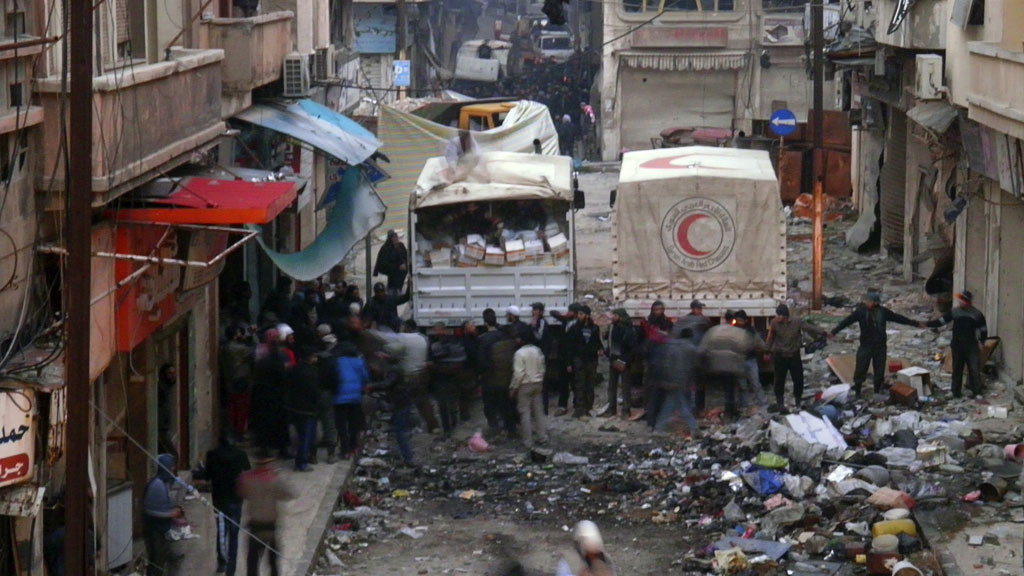Syria unrest: aid workers return to besieged city of Homs
Aid workers resume humanitarian operations in Homs – a day after they came under fire in the besieged rebel heart of the Syrian city.

Homs governor Talal al-Barazi told Al Mayadeen television that 500 civilians were able to leave the devastated neighbourhoods in central Homs.
Syrian state television said humanitarian supplies were also sent into districts where rebel fighters and civilians have been besieged for a year and a half, despite coming under fire from rebel forces.
It did not say whether anyone was hurt in the attack, which if confirmed would be a further violation of a three-day humanitarian ceasefire which expires on Sunday evening.
Aid convoy under fire
President Bashar al-Assad’s authorities and rebel fighters have traded accusations of responsibility for attacks which stranded a joint United Nations and Syrian Red Crescent team in central Old Homs for several hours after dark on Saturday.
The convoy was targeted just as the relief workers were handing over food and medical supplies.
The Red Crescent said one of its drivers was lightly wounded but the rest of the team eventually left central Homs safely.
Video footage released by activists showed the joint team, led by UN humanitarian coordinator in Syria Yacoub el Hillo, taking refuge on Saturday in a basement while explosions rocked the rubble-strewn, devastated streets above them.
In another video filmed inside Homs on Saturday, Hillo said the aid supplies, including food parcels, medicines and hygiene kits, were just a drop in the ocean when set against the conditions endured by people trapped for a year and a half.
“When I look around me and see the level of need, and suffering of all – especially the children, the women and the elderly – let me say that even though it’s a significant amount of medical and nutritional aid, it’s still just a drop,” he said. “But let’s start with this drop”.
On Friday, the first of the planned three-day humanitarian operation in Homs, 83 women, children and elderly men were evacuated from the ruins of central Homs, significantly fewer than the 200 which the city governor had predicted.
Many showed signs of malnutrition, the United Nations said.
Photo from old city #homs where the aid was delivered today. pic.twitter.com/kRctc4JNLn
— Syrian Red Crescent (@SYRedCrescent) February 8, 2014
Barrel bombs
Syria’s conflict has killed 130,000 people, driven millions from their homes and devastated whole city districts – particularly in Homs, a centre of protest when the 2011 uprising against 40 years of Assad family rule first erupted.
The evacuation of civilians and delivery of aid was the first concrete, though modest, result of talks launched two weeks ago in Switzerland to try to end the civil war.
At the Geneva peace talks, which resume on Monday, international mediator Lakhdar Brahimi has been pushing for agreement on aid deliveries and prisoner releases, hoping progress on those issues could build momentum to address the far more contentious question of political transition.
President Assad’s government has rejected out of hand any surrender of power in Geneva, and on the ground his forces have made gains while rival rebel forces battle each other in the north and east of the country.
On Sunday activists reported at least 11 people were killed in the northern city of Aleppo when helicopters dropped barrel bombs on rebel-held neighbourhoods.
Video footage purporting to show the aftermath of once such attack in the Haidariya district showed at least nine corpses, including one child, scattered across a wide highway, flooded by a broken water pipe.
Cars were still on fire and black smoke rose from the flames. Wounded men were carried into ambulances and one man could be seen carrying a severed leg from the scene, as women screamed in grief.